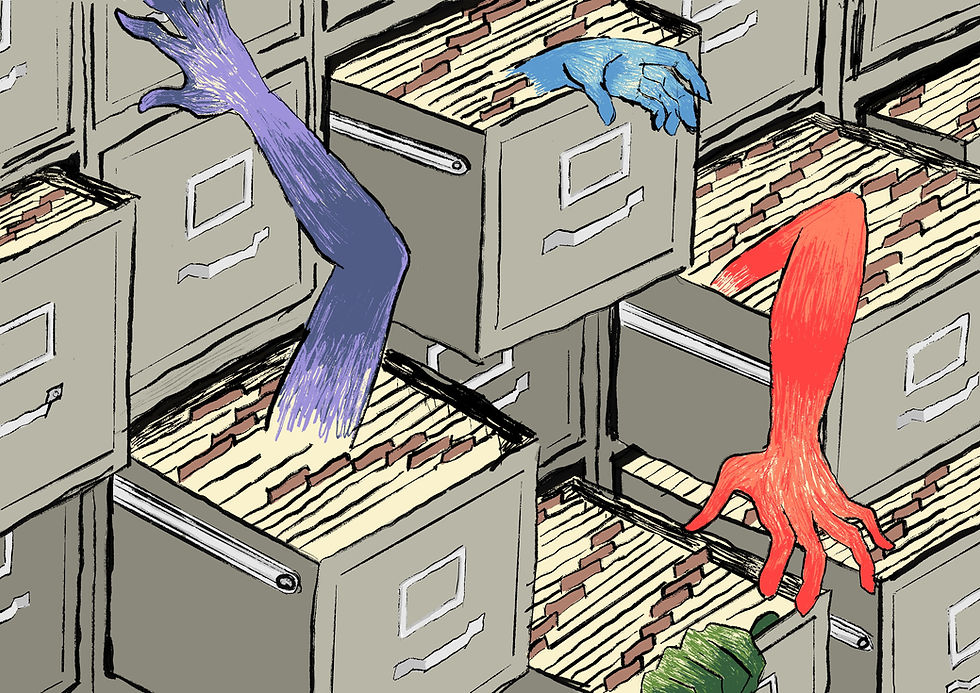Where Archive Lives
- Gabriela McBride
- Jul 14
- 4 min read
Updated: Jul 31
On ephemera and utopian schemes.
By Gabriela McBride

Illustration by Isabelle Oh
On 7th Street and 5th Avenue, tucked into a residential street in Park Slope, lives the Interference Archive. The archive welcomes you from first contact. There is no barrier to entry; in fact, it’s sometimes hard to find someone to tell you what you can or cannot touch. Volunteers bustle in and out of the front door, neighbors and visitors drop off materials, and students engaged in research sit in the back, combing through box after box. The archive is an open stacks collection that relies completely on donated materials and volunteer work. It focuses on preserving the cultural production of radical social movements throughout time, often those that fell between the cracks of mainstream historical narratives.
The space isn’t a museum, a memorial to old ideas, or a gravesite for outdated publications. It’s a living, breathing space for practice, activity, and dissemination of information. Interested in more than just documenting activism, the space nourishes the past, present, and future of grassroots movements and radical struggles, moving with time. While a traditional archive might ask visitors to wear gloves or not to touch things at all, Justin, who’s volunteered at the archive for two years, spoke to me about the value of visitors’ physical contact with the ephemera. “We want people to touch it. If it falls apart, that's what happens.” He explains that the physicality of the materials isn’t necessarily what’s important, but rather “the idea of the material. We'll recreate things we have to.”
Amelia, another volunteer at the archive, similarly emphasized that the materials at the archive are not just for being looked at, but for being used. “While yes, we’re literally preserving the paper and stuff, but also, preserving the function. I think that sequestering something away does objects a disservice. Activating the materials is so important.”
Beyond engaging the materials, Interference Archive actively works on mobilizing its community to transform theory into action. Staffing follows a non-hierarchical structure. At least once a week, an exhibition, workshop, or material distribution event is held in the space: This Is Not A Local Struggle, a look at ephemera produced by the national Stop Cop City movement, a Palestine Lives exhibition organized with Archivists and Librarians for Palestine, and earlier this month, a Know Your Rights materials distribution event, where attendees left with stacks of printed pamphlets, zines, and red cards to distribute to their neighborhoods. Each of these events are open to the public, and in this way, learning from the materials it holds, the archive is also involved in the creation of new materials, spreading the ideas it preserves, to the world outside itself.
Working as a volunteer at the archive this summer has been a reminder that learning about the past is not a passive act, but rather an ongoing dialogue. As a history major at Columbia, I am far too familiar with a certain approach to history that has a reverence for the oldness of things without applying it to our present, or acting upon that present.
As fellow students, awakened by historical and theoretical tools which Columbia gives them, face intense institutional and police repression for engaging in civil disobedience, I feel more and more convinced that the University is losing its function. Like the Interference Archive, the university should be a living, active space; a place where ideas are applied to practice.
I’m reminded of Randolph Bourne, an essayist, social critic of the early 1900s, and a Columbia student, who, more than a hundred years ago, wrote an article for the Spectator criticizing Columbia’s labor practices and treatment of custodial staff. After receiving a critical response from a professor for having overly utopian expectations for the University, Bourne responded in the paper writing: “I would say that I emphatically do expect my University to be a place for ‘trying out Utopian schemes…’ I expect it to be bigger and better and braver and more generous in its treatment of all its fellow-workers, than private business organizations run for profit” (Spectator Archives).
While mainstream narratives aim to minimize and condescend student movements into insignificance, the archive can act as a way to remind us of a tradition of analogous moments in years past. Must we be reminded every ten years that we ought to feel like a part of a constituency? That there have long been calls for participatory democracy? That receiving an education is to come to demand better of the institutions around us? If the can university is no longer a safe space for students to fully and critically engage with the past, alternative spaces like the Interference Archive might serve as a partial remedy.
During my first shift working at the archive this summer, I found a box labeled “Student Movements” containing a yellowing copy of the Port Huron Statement, falling apart in my hands. In it, next to a description of a democratically run university, an annotator had written “How Long!?”
Not yet.


